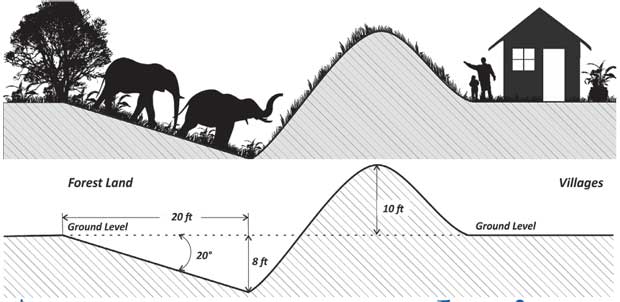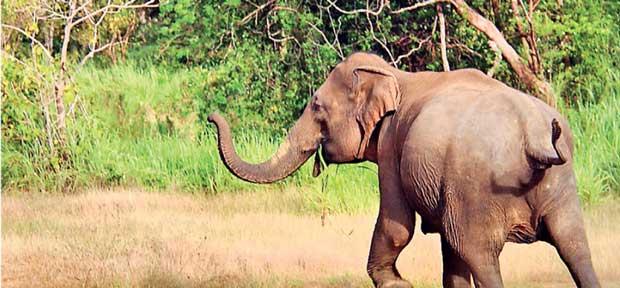Minister of Environment tells world forum Lanka has zero tolerance on marine pollution
Industrial and economic growth had negatively affected the environment surrounding Sri Lanka, Deputy Minister of Environment and Mahaweli Development Anuradha Jayaratne said addressing the Global Environment Forum 2016 in China recently. Jayaratne said possible pollution risks were very high with the further expansion of the industrial sector, especially on the marine environment.
He said coastal pollution was becoming a very hot issue in the country and globally. As a result, sea biodiversity was facing high risks and showing species extinction situation even at present level.
On the subject of ‘Embracing a new era with eco- civilization, he said some important new avenues that were being opened by his government to face global challenges of climate change resulting in natural disasters, Jayaratne said.
He said the government would take measures to prevent greenhouse gas emission and deforestation in the country.
“We launched Sri Lanka NEXT – A Blue Green Era, a land mark campaign to ensure the development of low carbon path ways for sustainable development by minimizing the impact of climate change on human life, eco systems, natural assets and the economy in January to mitigate the environment impacts of new industries,” Jayaratne said.
The Marine Environment Protection Authority of Sri Lanka was devoted to the ocean conservation as an island in the Indian Ocean and a substantial amount of the country’s income was generated from tourism due to its beautiful beaches and marine life, the Deputy Minister said.
Jayaratne said the relevant ministries had adopted strict policies to prevent over fishing in order to ensure the safety and longevity of marine life and regulations were in place to prevent fishing in breeding seasons at different locations. The government also had a zero tolerance on marine pollution and waste disposal at sea and a well-established policy framework to protect the marine life.
Source : http://www.island.lk/index.php?page_cat=article-details&page=article-details&code_title=148876

Ban on agro-chemicals seen as jeopardising SL’s agricultural sector
“Sri Lanka will experience climate change issues in temperature, rainfall, evaporation and sea level rises in the future. The ban on agro -chemicals puts the entire country into a difficult scenario, immediate past president National Agribusiness Council Aruna Weerakoon said.
“This will affect a range of sectors, such as agricultural production, including export crops, in the future. Ban of agro- chemicals without a proper plan has resulted in a reduction of agricultural crop production, including commercial and export crops, Weerakoon told The Island Financial Review.”The entire agriculture sector will be impacted on account of changing weather patterns and climate. But with the increase in temperature, pest control becomes a major issue for farmers and the ban on pest control chemicals in the market adds insult to injury, Weerakoon said. “Water resources planning, development and management are essential for sustainable climate adaptation in Sri Lanka but due to a lack of knowledge on the part of farmers and a lack of funds/finance among them, the entire sector will likely be plunged into a major crisis, he said.
“Urgent action is needed to ensure Sri Lanka is better prepared to address future climate conditions, including anticipated extremes of flooding and drought, he added. Weerakoon said that when the temperature level goes up, pests become a real problem but, unfortunately, our farmers don’t have powerful chemicals to arrest the situation. Therefore, this would result in lower agricultural productivity in the country.
According to research presented at a recent conference, primary climate change effects on water resources include increased temperatures, changes in annual rainfall, changes in monsoon seasonality, increased variability and sea level rises.
Weerakoon explained that to feed the population, the commercial agriculture sector should be streamlined to withstand climate changes. “This could be done by introducing modern technology, like greenhouses, to the sector,” he said.
He said that surface and groundwater quality in coastal areas is also likely to be impacted, affecting important drinking water supplies including water to the agriculture sector.
This, in turn, will result in secondary effects, like increased transpiration, changes in river flows, groundwater recharge, snow and glacial melt.

GCF green light for Sri Lankan proposal
The Green Climate Fund (GCF), the main international funding body for climate action, has approved USD 38.1 million for Sri Lanka for its proposal titled ‘Strengthening the Resilience of Smallholder Famers in the Dry Zone to Climate Variability and Extreme Events through an Integrated Approach to Water Management’.
The proposal prepared by the Mahaweli Development and Environment Ministry with the assistance of the United Nations Development Programme (UNDP) was approved at the 13th Board Meeting of GCF in Korea recently.
The UNDP issuing a press release stated the project aims to achieve higher levels of food, livelihood and water security for communities in the Dry Zone of Sri Lanka.
This is the first time that Sri Lanka has received funding from the GCF. UNDP Resident Representative of Sri Lanka Peter Batchelor said this is “the largest ever proposal to be approved”.
The seven-year project is to commence in December 2016 and is to be completed by the end of 2023. The project will benefit about 1.5 million people.
“GCF resources will be invested in improving the community irrigation water infrastructure and associated agricultural practices, scaling-up decentralized drinking water systems and strengthening Early Warning, forecasting and water management systems to enhance the livelihood and resilience of smallholder farmers, particularly women, from climate related impacts. The resources will allow assistance to be provided to 910,000 people in three river basins – Malwatu Oya, Yan Oya and Mi Oya – who are vulnerable to climate change. Moreover, around 712,000 people living in the same areas will indirectly benefit from the project,” the release stated.
Further to the grant from the GCF, the Sri Lankan government will leverage government co-financing amounting to USD 14 million for this project to address several financial, technical, and institutional barriers related to achieving integrated water management to improve agriculture-based livelihoods of smallholder farmers in the Dry Zone.
In addition to Sri Lanka’s proposal, the Board approved eight other proposals. Among these are proposals from El Salvador, Armenia, Gambia, Mali, Vietnam, Tajikistan/Uzbekistan, Tuvalu and Chile.
(Source :20/07/2016 Daily News http://www.dailynews.lk/?q=2016/07/20/local/87989)

A permanent solution to Man-Elephant conflict
Today the well publicised man vs. elephant conflict in certain parts of the country has reached dismal levels and needs immediate attention to address this despicable situation in a more pragmatic manner.
It appears that all concerned parties are desperately looking for an effective and permanent solution which has not yet seen the light of day. Poor innocent peasants are dying or are maimedin great numbers and are helplessly left to protect themselves while killer elephants are freely rampaging in human habitations causing irreparable damage and destruction to life and property. Hardly a day passes sans the news of elephant attacks in some part of the country.
Conversely on the other hand the numbers of elephants killed by the enraged villagers using illegal methods of various makes are also steadily increasing.
“The slider-bank system needs no procurement of any raw material and would last for over 100 years “
This situation has aggravated due to a number of factors. First is that the forest cover which is the wild native habitat of the pachyderm has been rapidly dwindling due to vast deforestation brought about by development projects, housing schemes and politically patronised encroachments.
Secondly due to the overwhelming upsurge in the elephant population based on the State-sponsored protection extended to this specific species. With this present scenario the conflict will go from bad to worse sooner than later with no effective solution in the foreseeable future to protect both man and elephant.
Electric fence – a failure
Electric fence has been proved to be a total failure, despite the exorbitant cost on installation and maintenance. The electric fence is often unoperative, breached or out of commission due to negligence or practical difficulties faced in essential regular maintenance. Adding to these inadequacies, the elephant being a shrewd animal, has improvised its own manoeuvres to circumvent or resist the deterring effects of the electric fence according to what we hear from the villagers. At this rate the future generations of our endemic elephant species will carry still more enduring resistance capability through gene transfer over to their subsequent line of descent to withstand even a more powerful electric shock. Hence we have to look for a more effective and long-lasting method to address this menacing issue. 
Slider-Bank System
At this instance, I would like to suggest a totally successful method to prevent these pachyderms crossing over to areas of human habitation. I would name this method as the ‘slider-bank system’. The slider-bank system needs no procurement of any raw material and would need only minimal maintenance
if at all. It would be a successful method and would last for over 100 years. All what it needs to be installed is some earth excavating machinery and their operators until it is put in place. The slider-bank system is based on the basis that these massive creatures cannot climb steep elevations by their very nature.
As the elephants are restricted to State-owned forest land there would be no need for the procurement of private land or property. The slider-bank is to be built in the following manner.
On the side of the forest land about 20 feet away from the demarcated boundary (that separates the forest land from the village area) the excavation should begin and proceed in a gradual declining angle of 20 degrees sliding towards the boundary line where the excavation will attain a depth of 8ft. (approx.) when it reaches the boundary. All the earth so excavated should be heaped on the opposite side of the boundary creating an earth embankment which would stand to an envisaged height of 10ft. Then with the depth of the 8ft. entrenchment the embankment would attain a total height of 18ft. (approx.) creating a steep and strong barrier which would make it impossible for these heavy creatures to climb and cross over. Once built, it needs no maintenance. Optionally, if necessary narrow pass-through gaps or arches may be provided at required locations for the villagers to cross over to the reserved area. Within a few months the embankment will consolidate and settle firm and tight. Grass and shrubs will quickly grow on it further reinforcing its strength. The villagers would gladly volunteer to maintain it if and when needed at all.
With this permanent barrier the villagers will be able to enjoy peaceful nights sans the fear of elephant attacks and the elephants will be safe from being met with cruel circumstances. In my estimation this project will cost much less than what it costs to install and continually mend and maintain the electric fence which has hitherto been seen as not standing to the ‘desired expectations’ due to various maintenance problems and other reasons. It is my hope that the authorities in power would consider this proposal favourably and may develop it further if necessary, and expedite it for the benefit of both the helpless villagers and the endangered pachyderms





